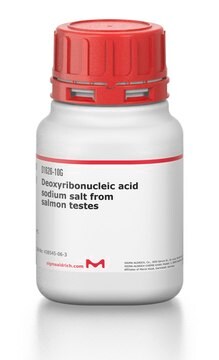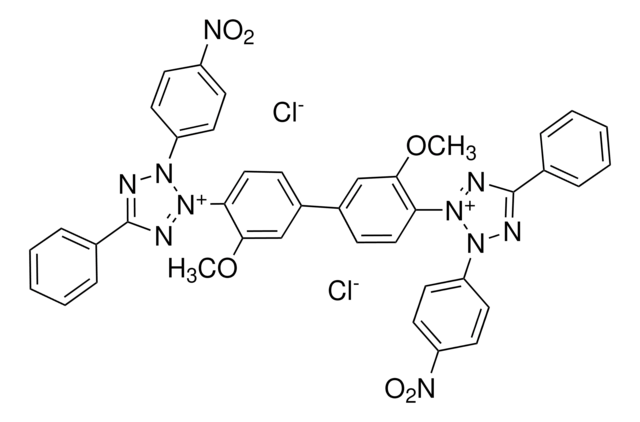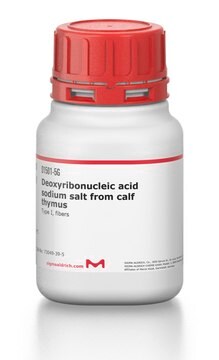T6632
Thymidine Phosphorylase, recombinant from Escherichia coli
recombinant, expressed in E. coli, buffered aqueous solution, ≥900 units/mL, 0.2 μm filtered
Sinonimo/i:
Thymidine:orthophosphate deoxy-D-ribosyltransferase
Autenticatiper visualizzare i prezzi riservati alla tua organizzazione & contrattuali
About This Item
Numero CAS:
Numero MDL:
Codice UNSPSC:
12352204
NACRES:
NA.54
Prodotti consigliati
Ricombinante
expressed in E. coli
Livello qualitativo
Sterilità
0.2 μm filtered
Stato
buffered aqueous solution
Concentrazione
≥900 units/mL
N° accesso UniProt
Temperatura di conservazione
2-8°C
Informazioni sul gene
Escherichia coli K12 ... deoA(948901)
Cerchi prodotti simili? Visita Guida al confronto tra prodotti
Descrizione generale
Thymidine phosphorylase inhibits vascular smooth muscle cell proliferation.
Applicazioni
Thymidine phosphorylase has been used in a study to evaluate biomarkers for advanced breast cancer patients treated with capecitabine-based first-line chemotherapy. Thymidine phosphorylase has also been used in a study to investigate implications for the clinical efficacy of nucleoside analogues.
Azioni biochim/fisiol
An enzyme that catalyzes the reversible conversion of thymidine to thymine. Thymidine phosphorylase is part of the pyrimidine nucleoside salvage pathway. This pathway allows pyrimidine bases to be recycled for nucleotide biosynthesis, while the pentose 1-phosphates are converted to intermediates of the pentose phosphate shunt and glycolysis. The E. coli thymidine phosphorylase shares 40% sequence homology with the human sequence, which has been found to be identical to the angiogenic agent platelet-derived endothelial growth factor. The purified E. coli enzyme has been shown to stimulate blood vessel growth in chick chorioallantoic membrane assays.
Definizione di unità
One unit will convert 1.0 μmole each of thymidine and phosphate to thymine and 2-deoxyribose 1-phosphate per min at pH 7.4 at 25°C.
Stato fisico
Solution in 0.5 M potassium phosphate containing 2 mM uracil, 0.02% sodium azide and bovine serum albumin
Nota sulla preparazione
Cloned from E. coli and produced in overexpressing E. coli
Codice della classe di stoccaggio
12 - Non Combustible Liquids
Classe di pericolosità dell'acqua (WGK)
WGK 2
Punto d’infiammabilità (°F)
Not applicable
Punto d’infiammabilità (°C)
Not applicable
Dispositivi di protezione individuale
Eyeshields, Gloves, multi-purpose combination respirator cartridge (US)
Scegli una delle versioni più recenti:
Possiedi già questo prodotto?
I documenti relativi ai prodotti acquistati recentemente sono disponibili nell’Archivio dei documenti.
Domenico Ribatti et al.
Expert opinion on therapeutic targets, 16(12), 1215-1225 (2012-09-18)
Several anti-angiogenic agents have been developed and some of them have been clinically applied in the tumor therapy. Anti-angiogenic therapy faces some hurdles: inherent or acquired resistance, increased invasiveness, and lack of biomarkers. Characterization of tumor endothelial markers may help
Richard A Norman et al.
Structure (London, England : 1993), 12(1), 75-84 (2004-01-17)
Human thymidine phosphorylase (HTP), also known as platelet-derived endothelial cell growth factor (PD-ECGF), is overexpressed in certain solid tumors where it is linked to poor prognosis. HTP expression is utilized for certain chemotherapeutic strategies and is also thought to play
Alexandra Giatromanolaki et al.
Cancer biology & therapy, 13(13), 1284-1289 (2012-08-17)
Tumor-associated stroma (TAS) is not simply a supporting element for cancer cells, but plays an important role in tumor growth, invasion and metastasis. Changes on the level of stromal constituents, such as loss of Caveolin-1 and increased thymidine phosphorylase (TP)
Hong-Yun Zhao et al.
Anti-cancer drugs, 23(5), 534-542 (2012-04-07)
The aim of the present study was to investigate the gene expression of biomarkers associated with the sensitivity to fluoropyrimidine and taxanes in recurrent/advanced breast cancer patients treated with first-line capecitabine chemotherapy. We evaluated the clinicopathological/prognostic significance of thymidylate synthase
Michelle Levene et al.
Toxicological sciences : an official journal of the Society of Toxicology, 131(1), 311-324 (2012-09-15)
Erythrocyte-encapsulated thymidine phosphorylase (EE-TP) is currently under development as an enzyme replacement therapy for mitochondrial neurogastrointestinal encephalomyopathy (MNGIE), an autosomal recessive disorder caused by a deficiency of thymidine phosphorylase. The rationale for the development of EE-TP is based on the
Il team dei nostri ricercatori vanta grande esperienza in tutte le aree della ricerca quali Life Science, scienza dei materiali, sintesi chimica, cromatografia, discipline analitiche, ecc..
Contatta l'Assistenza Tecnica.







